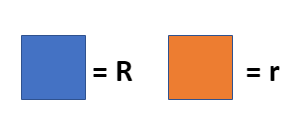Distance Learning Module: Getting Started with Binary Code
In this introduction to coding, learn how computers store information in numerical format and test your skills at reading & writing in binary!
01001000 01100101 01101100 01101100 01101111 00100001
Does this set of numbers look like a random jumble? Believe it or not, these numbers hold a special message just for you!
Want to learn how to read it? Like any code, to decipher the meaning of the message, all you need is the right key…
A code is a system of communicating that substitutes words, letters, or symbols with OTHER words, letters, symbols—even images. The meaning of the message is hidden, unless the reader knows what each piece of the code represents. To understand a coded message, you have to do some translating: moving from what the message says to what it means.
For example, if I gave you the following code:
you could read and write some words using just those shapes.
You would write ROOM like this:
And you would write DOOR like this:
How would you use this code to write MOOD?
What other words could you spell with just these 4 characters? (hint: they don’t all have to be four letters long!)
Try it!
Use shapes or symbols to come up with your own code, and use it to spell your name. To take it a step further, try using colors to signify upper and lower case.
There are many kinds of code in the world. For example, Braille uses a system of raised bumps to represent letters, allowing blind people to read information from a surface using their fingertips. Morse code uses dots and dashes—electronic signals that are very short or a little longer, if you hear them—to spell words. Computers use a system called binary code to send, receive, and store information.
The word “binary” means that something has TWO options. In binary code, messages are transmitted using combinations of only two symbols: the number 1 and the number 0.
Wires carry information
t
hrough a computer
in the form of electricity.
When binary code is transmitted as a series of 1’s and 0’s, each digit in the series is called a bit. 8 bits in a row is called a byte.
A computer that can only understand single-digit messages—for example, 1 = on and 0 = off—has a single bit processing capacity. This computer can only send and receive two possible messages: either 1 or 0. It can only carry out two commands.
A computer that understands two-digit messages has a two-bit processing capacity. There are now FOUR possible messages that it can send and receive: 00, 01, 10, and 11. Note that adding just one more bit to the sequence doubled the computer’s processing capacity.
If we add one more digit—sending three-bit messages—the computer would now be able to understand EIGHT possible messages: 000, 001, 010, 011, 100, 101, 110, and 111. We have doubled the processing capacity once again.
Increasing the number of bits allows a computer to carry out more, and more complex, commands.
Most computers send and receive messages using an 8-bit binary code—each letter and punctuation mark is represented by a series of 1’s and 0’s that is 8 digits long. To read a code in 8-bit binary, all you need is the key:
Remember the long series of 1’s and 0’s at the beginning of this lesson?
01001000 01100101 01101100 01101100 01101111 00100001
This message is written in 8-bit binary code, and the table above is the key we need to decipher it. We can use the table to translate the code from groups of 1’s and 0’s to the letters they represent. We can see from the key that:
01001000 = H
01100101 = e
01101100 = l
01101100 = l
01101111 = o
00100001 = !
The message 01001000 01100101 01101100 01101100 01101111 00100001 in binary code translates to H e l l o ! in English.
For a computer, each character of this message would be equal to 8 bits—or 1 byte—of memory. The entire message, which is 6 characters long, would require 8 x 6 = 48 bites (6 bits) of memory.
Try it!
Write your name in binary
Use binary code to write your name, representing each letter with a series of darkened and blank circles instead of 1’s and 0’s. A darkened circle represents a 1, and a blank circle represents a 0.
Make a binary bracelet or necklace
Create a paper bracelet with your initials in binary, and wear your coding knowledge for everyone to see! To take it a step further, string together actual beads on a piece of cord or a pipe cleaner. Decide which color of bead represents 1’s and which represents 0’s (similar to the darkened and blank circles in the activity above), and spell your entire name using the beads. You can even add different colors for upper and lower case.
What other objects can you use to send messages in binary? We found an example on this website that spells out words using peas and carrots!











